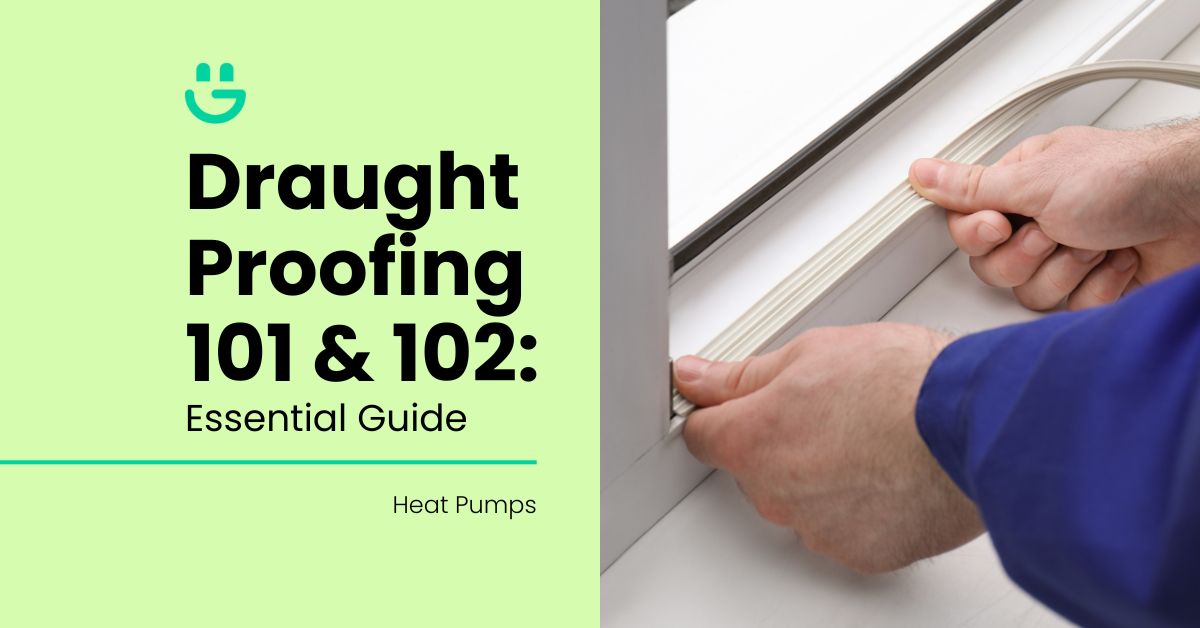Last Updated on April 30, 2024
Are you at wit’s end with a constant cold draught snaking through your home and robbing you of your warmth and cosiness? And even though your central heating system works at its maximum and your electricity bill reaches new heights, your home doesn’t seem to reach optimal heat.
This is where draught-proofing comes in. By sealing all those small and sometimes undetectable gaps through which your home loses heat, you can help keep your living space warm. Draught-proofing UK homes also helps households stay energy efficient and keep energy bills in check.
Use this guide from Eco Happy to learn about draughts, what causes them, and how to draught-proof your house to ensure maximum comfort and warmth this winter.
Contents
What Is A Draught?
A draught is a current of cold or warm air that enters or escapes your home through unsealed spaces or gaps around windows and doors, air vents, and other joints.
If left unchecked, draughts lead to higher energy bills as you continuously crank up your central heating system to compensate for the lack of heat, increasing fuel consumption and bumping up your carbon emissions.
Draughts lead to up to 30% of heat losses in many UK homes, with up to 18% of heat lost to draught-prone windows.
Why Draught Proof Your Home?
Draught-proofing your home helps you:
- Save costs. It’s your wallet’s best friend – Numerous studies have shown that a draught-free home uses less energy, saving homeowners up to 30% on their monthly energy bills.
- Save energy. Reducing energy usage reduces your household carbon footprint, helping homes become more energy efficient.
- Keep your home warm. Keeping the warmth inside your home reduces your heating needs and ensures a cosier and more comfortable living space.
Identifying And Dealing With Draught Problem Areas
The common culprits through which homes lose heat include:
Windows
The most draught-prone areas in homes are often windows. Improperly fitted window frames and panes have gaps through which heat can escape, reducing indoor temperatures.
Stand next to the window and use the back of your hand to feel for cold air entering through unsealed cracks and gaps. If you have double-glazed windows fitted, check for condensation between the window panes, which indicates an air leakage. For sliding sash windows, check for a broken locking mechanism which can prevent windows from closing properly, allowing warm air to escape.
If you don’t have double-glazed windows (yet) but you’re considering it, we’ve prepared a guide on whether double-glazing is worth it to inform your decision. But how does double-glazing work to keep you warm? A thin layer of air is trapped between the two glass panes, which acts as an insulator.
Properly sealing normal and sash windows can help you save up to £100 per year per window, leading to immense savings over the long term.
Draught-proofing windows
Use these handy tips to draught-proof windows:
- Replace broken window locks with new ones.
- Seal any gaps in double-glazed windows with draught-proofing strips to prevent the build-up of condensation between window panes. If this doesn’t work, replace your old windows. We’ve got a guide on the cost of double-glazed windows so you know what the replacement costs will be.
- Seal gaps around the window frame using isolation strips. These metal or plastic strips prevent warmth from escaping outside. Use self-adhesive sealing strips or draught excluders to seal gaps in sash window frames. Replace warped, old wooden frames with newer, better-sealing frames.
Doors
Because doors continuously open and close, they allow air to enter or escape your living space. However, when closed, gaps around door frames are another frequent entry point for cold draughts.
Use the back of your hand to check for cold air streams along the entire door frame, at the keyhole, letterbox, and cat door – if you have one.
Households can save up to £50 per year per door if gaps are draught-proofed.
Draught-proofing doors
To seal gaps along your doors:
- Ensure that your doors have a snug fit with the doorframe.
- Install plastic draught strips or brush strips between the door and frame.
- Use a draught excluder or threshold seal along the bottom of your door to stop the inflow of cold air.
- Cover up keyholes, letterboxes, and cat flaps using specially designed covers, flaps, or brushes.
Chimneys
Chimneys act as wind tunnels through which warm air can escape, causing heat loss.
Stand by your chimney and try to feel for any cold draughts. Also, try to listen for air getting sucked out via your chimney.
Draught-proofing your chimney can save you up to £100 annually on your energy bill.
Draught-proofing your chimney
To reduce the possibility of losing heat through your chimney:
- Install a chimney sheep, balloon, cap, or chimney draught excluder.
- Fill up your fireplace. If you do not use your fireplace, this method, though costly, can help permanently eliminate losing heat via your chimney.
Pipework
The pipes and electrical wiring in your walls can also create gaps through which cold air can enter your home.
Run the back of your hand along the areas where pipes or electrical wiring run to detect gaps.
How to draught-proof pipework
To prevent draughts around your home’s pipeworks: Seal gaps using expanding foam or caulk.
Loft hatches
Warm air rises and can easily escape through a poorly insulated loft hatch, leading to significant heat losses.
Stand close to your hatch and listen for draughts. You can also climb into your loft, close the hatch, and feel for cold air with your hand.
Sealing leaky loft hatches can save households up to £200 annually.
Draught-proofing a loft hatch
To prevent heat loss through loft hatches: Seal your hatch using foam strips or strip insulation to prevent heat from escaping.
Floorboards
Small gaps between floorboards can let in cold air.
Walk around your home barefoot to feel for cold draughts.
The monthly savings on your energy bill depend on the number of loose floorboards you’ll need to seal or replace.
Draught-proofing floorboards
To prevent heat losses through the floor:
- Seal loose boards using silicone-based filler.
- Replace old or warped floorboards to ensure a snugger fit.
- Use draught-proofing strips around the edges of your floors to block out the cold.
- Install floor insulation.
Skirting
Small gaps behind your skirting boards can be another entry point for cold air.
Use the back of your hand to detect gaps along the skirting boards.
The amount of annual savings you’ll enjoy on your energy bills will depend on the number of gaps between the boards that require resealing.
Draught-proofing skirting boards
To prevent heat loss:
- Seal gaps between skirting boards using caulk, sealant, or draught-proofing strips.
- Replace old, warped boards to ensure a more air-tight fit to stop draughts from leaking through.
Old extractor fans
An ill-fitting extractor fan sucks heat out of your home. You can use the back of your hand to check for any draughts along the edges of the fan.
UK homes can save up to £50 annually on energy bills if they draught-proof old extractor fans.
Draught-proofing extractor fans
To prevent warm air from escaping:
- Seal gaps around your extractor fan with caulk or silicone.
- Replace old extractor fans. Installing energy-efficient extractor fans with built-in draught excluders can significantly improve your home’s energy efficiency.
- Block up old extractor fan vents. If you decide to remove and not replace an old extractor fan, block up the old vents using polyurethane foam.
FAQs
What are draught excluders?
Also known as a door snake, draught stopper, or wind stopper, a draught excluder seals gaps between the bottom of the door and the floor, preventing cold air from entering a room. These budget-friendly draught-busters are a quick and easy way to keep heat inside your living space.
What are the disadvantages of using a draught excluder?
Though easy to install and often one of the most affordable ways to draught-proof your home, draught excluders have some drawbacks:
- A worn and loose-fitting fabric draught excluder may move around and get stuck between the door and the floor.
- A foam strip under-door draught excluder might make it difficult to close or open tight-fitting doors.
- A self-adhesive draught excluder needs precise installation and may damage the finish of your doors.
How can I further increase my home’s heat-retaining capabilities?
Try these tips to help keep your home warm and toasty this winter:
- Install secondary glazing on windows to create an insulating air pocket that traps heat and blocks draughts. Secondary glazing is also great for providing sound insulation.
- Use thermal blinds and curtains. Thermal blinds with reflective backs can bounce heat back into your room, while thick curtains are an additional barrier against draughts around your windows. Keep blinds and curtains open during the day to use sunlight to warm your rooms, while closing them at night helps trap heat.
- Consider insulating your loft and wall cavities to help trap heat in your living spaces.
Can I DIY my home’s draught-proofing?
Yes. DIY draught-proofing your home is a budget-friendly and easy way to save energy and eliminate draughts. However, for more labour-intensive tasks, such as replacing and fitting new windows or sealing vents and old chimneys, consult an experienced professional.
Conclusion
Draughts can rob your home of much-needed heat during the cold winter months. Reducing the gaps and unsealed spaces through which hot air escapes can significantly reduce draughts.
Not only can draught-proofing problem areas in your home boost comfort levels, but it also helps reduce energy usage and cut down on monthly energy bills.
Use our simple energy-efficient home tips to draught-proof your living spaces today (plus you learned a thing or two about how to save on your electric bill).
Contact Eco Happy for advice on which other cost-effective energy-saving solutions to implement to ensure a warm and cosy home this winter.






James Elston
Boiler Expert
James Elston is the top boiler replacement and heating expert at Eco Happy. He has over 20 years of experience in the industry, focusing on Gas Safe boiler installations and offering home-heating and energy-saving solutions to homeowners across the UK. From sourcing the most energy-efficient combi boiler to providing specialist heating advice, James ensures that Eco Happy maintains the highest standards and best customer service.